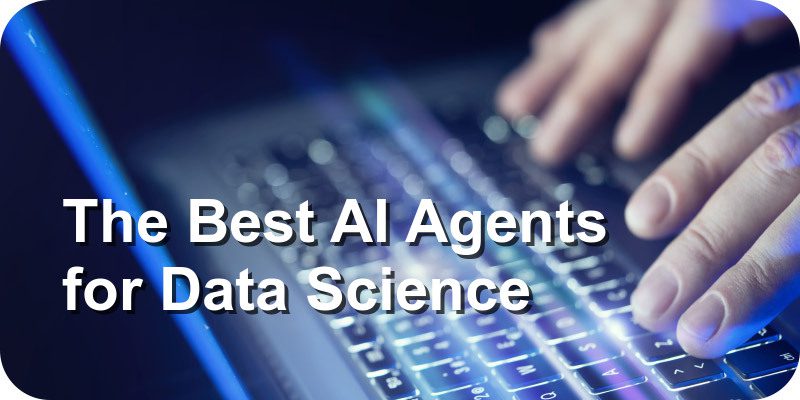The 12 Best AI Agents for Data Science to Consider in 2025


Solutions Review Executive Editor Tim King explores the emerging AI application layer with this authoritative list of the best AI agents for data science.
The proliferation of generative AI has ushered in a new era of intelligent automation — and AI agents are at the forefront of this transformation. From code-generating copilots and experiment tracking assistants to autonomous agents that clean data, test hypotheses, and optimize models, AI agents are rapidly reshaping how modern data science teams explore, analyze, and operationalize data.
In this up-to-date and authoritative guide, we break down the top AI agents and agent platforms available today for data science, grouped into clear categories to help you find the right tool for your specific needs — whether you’re prototyping models, conducting exploratory data analysis, or scaling experiments across environments.
This resource is designed to help you:
- Understand what makes AI agents different from traditional data science and analytics tools
- Explore the capabilities and limitations of each available agent or agent-enabled platform
- Choose the best solution for your team based on use case, technical expertise, and project goals
Whether you’re building predictive models, refining features, running automated experiments, or deploying ML pipelines — there’s an AI agent for that.
Note: This list of the best AI agents for data science was compiled through web research using advanced scraping techniques and generative AI tools. Solutions Review editors use a unique multi-prompt approach to employ targeted prompts to extract critical knowledge to optimize the content for relevance and utility. Our editors also utilized Solutions Review’s weekly news distribution services to ensure that the information is as close to real-time as possible.
The Best AI Agents for Data Science
The Best AI Agents for Data Science: Enterprise AI Platforms for Machine Learning & Analytics
Full-stack platforms offering model training, deployment, governance, and analytics for structured and unstructured data across business environments.
H2O.ai
Use For: Automated machine learning (AutoML), model explainability, and enterprise-grade predictive analytics
H2O.ai is a leading open-source AI platform focused on delivering automated, interpretable machine learning at scale. Its flagship products — including H2O-3, Driverless AI, and H2O Wave — enable users to build, deploy, and monitor machine learning models with ease, whether you’re a coding expert or a business analyst.
What sets H2O.ai apart is its commitment to responsible AI, combining the power of automation with tools for explainability, governance, and model fairness. It’s ideal for organizations that want to leverage AI not just for analysis, but for real-world decisions in sectors like banking, insurance, manufacturing, and healthcare.
Key Features:
- Automated feature engineering, model selection, tuning, and validation
- Supports structured and time-series data with minimal configuration
- Includes built-in tools for model explainability (e.g., SHAP, LIME)
- Integrates with Python, R, Spark, Snowflake, and REST APIs
- Offers visual dashboards via H2O Wave for building custom AI apps
Get Started: Use H2O.ai when your organization needs trustworthy, high-performance machine learning models with transparency — especially if you operate in a regulated industry or require AutoML for mission-critical analysis at scale.
DataRobot
Use For: Enterprise AutoML, model lifecycle management, and production-ready predictive analytics
DataRobot is a leading enterprise AI platform known for its automated machine learning (AutoML) and end-to-end AI lifecycle management capabilities. Designed to help organizations build, deploy, and monitor machine learning models at scale, DataRobot empowers both technical and non-technical users to extract insights from data and make accurate, AI-driven predictions.
DataRobot functions like a smart assistant for the entire machine learning pipeline. From ingesting raw data to selecting algorithms, tuning models, and surfacing explainable insights, it handles the heavy lifting behind the scenes — making AI more accessible to business teams while remaining powerful and customizable for data science professionals.
Key Features:
- Automated model selection, tuning, validation, and deployment
- Native support for tabular, time series, text, and image data
- Built-in explainability tools (e.g., SHAP values, bias detection, and decision insight graphs)
- Monitoring and governance features for model performance and drift
- Cloud-native and hybrid deployment support (SaaS, on-prem, or multi-cloud)
Get Started: Use DataRobot when your organization needs to operationalize AI quickly and responsibly, especially across teams that want repeatable, explainable, and monitored machine learning workflows — without having to build the infrastructure from scratch.
Databricks Lakehouse AI
Use For: Unified data analytics, large-scale machine learning, and enterprise-grade AI workflows
Databricks is a leading enterprise data platform built around the Lakehouse architecture, which combines the scalability and reliability of data warehouses with the flexibility and openness of data lakes. While not a traditional “AI agent,” Databricks powers AI-driven data analysis through its integration of Apache Spark, MLflow, Delta Lake, and large language models (LLMs) — enabling the creation of intelligent, end-to-end data pipelines.
As of 2025, Databricks supports agent-based analytics, allowing users to build and deploy LLM-powered copilots, bots, and assistants directly inside their Lakehouse environments using Databricks Model Serving, Unity Catalog, and Lakehouse AI.
Key Features:
- Built-in support for LLMs, AutoML, and foundation models
- Seamless transition from raw data to production-ready AI workflows
- Real-time data streaming and event-driven AI capabilities
- Governance, versioning, and observability with Unity Catalog and MLflow
Get Started: Use Databricks when you need a secure, unified, and scalable environment for data analytics and machine learning—especially if your team is building internal AI agents or copilots that must reason over enterprise data in real-time.
TIBCO Spotfire
Use For: AI-augmented data visualization, real-time analytics, and interactive dashboarding
TIBCO Spotfire is a leading data analytics and visualization platform that combines advanced analytics, real-time data streaming, and AI-powered insights in a highly interactive, user-friendly environment. It’s designed to help organizations rapidly explore, visualize, and interpret complex datasets — making it a go-to platform for industries where data is constantly flowing and decisions need to be made quickly.
Spotfire stands out for its ability to augment human analysis with built-in AI recommendations, helping users detect patterns, trends, anomalies, and correlations that might otherwise be missed. It supports both code-free exploration and advanced scripting (R, Python, SQL), giving teams flexibility at all technical levels.
Key Features:
- AI-driven “Recommendations Engine” that suggests visualizations and analyses
- Real-time analytics support via TIBCO Data Streams for IoT and live systems
- Integrated geoanalytics for location-based insights
- Supports predictive modeling, data wrangling, and custom expressions
- Flexible deployment (on-premises, cloud, or hybrid environments)
Get Started: Use Spotfire when your team needs fast, intuitive insight from complex or streaming data, especially in domains like manufacturing, energy, pharma, or logistics, where visualizing data in real time can improve operations and drive decisions.
Want the full list? Register for Insight Jam [free], Solutions Review‘s enterprise tech community enabling the human conversation on AI, to gain access here.































